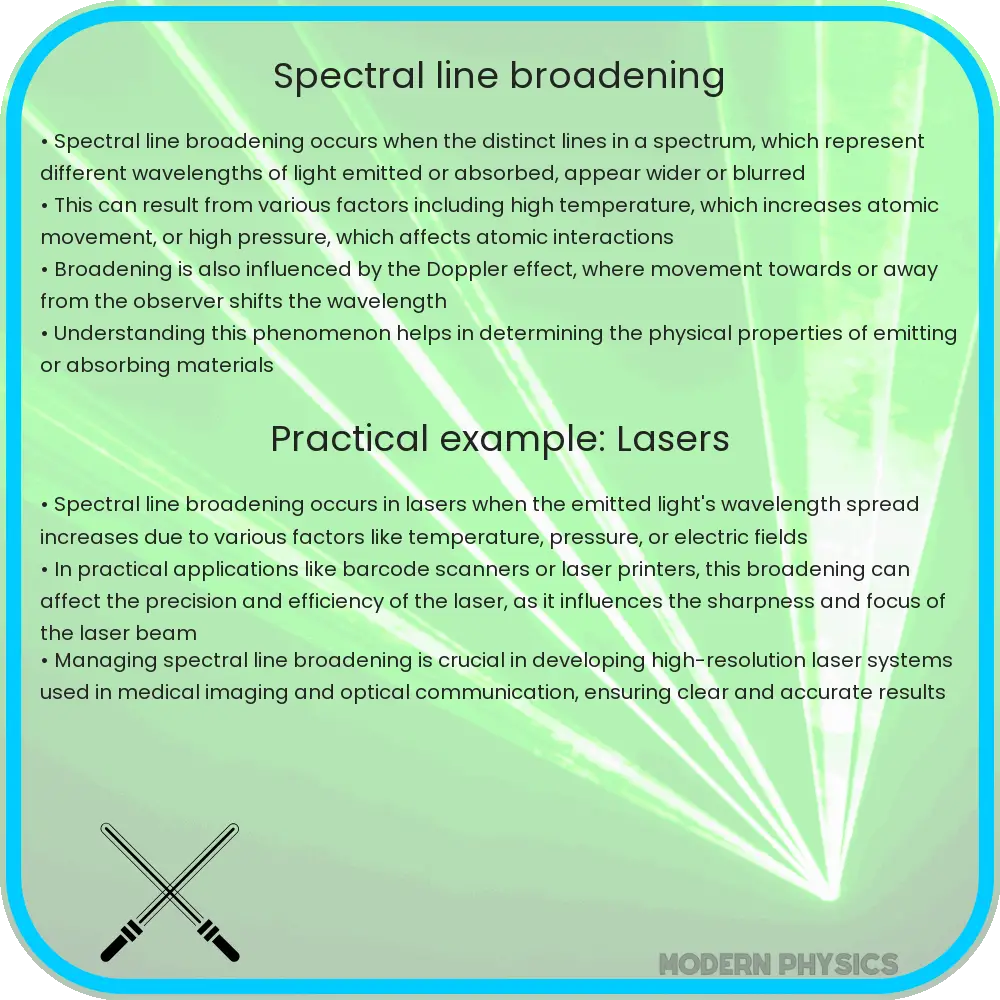Explore the causes and effects of spectral line broadening in astrophysics, including natural, Doppler, collisional, and Zeeman broadening, and their impact on celestial analysis.

Spectral Line Broadening: Understanding the Basics
Spectral line broadening is a phenomenon observed in astrophysics that refers to the widening of features within the electromagnetic spectrum of emitted light from stars and other celestial bodies. This broadening is crucial for understanding various astrophysical processes and conditions. There are several factors contributing to this phenomenon, each with its unique implications for the study of the universe.
Causes of Spectral Line Broadening
The broadening of spectral lines can be attributed to several mechanisms:
- Doppler Broadening: This is caused by the relative motion of the light-emitting source and the observer. If the source is moving towards the observer, the lines shift towards the blue end of the spectrum (blue shift); if it’s moving away, they shift towards the red end (red shift). This effect is described by the Doppler formula: Δλ/λ = v/c, where Δλ is the change in wavelength, λ is the original wavelength, v is the velocity of the source, and c is the speed of light.
- Pressure Broadening: Also known as collisional broadening, this occurs when the emitting atoms or molecules are perturbed by collisions with other particles. The increased pressure, especially in stellar atmospheres, leads to a broadening effect as the energy levels of the emitting particles are altered.
- Thermal Broadening: At high temperatures, particles move more rapidly due to thermal energy, leading to a spread in the velocities of emitting particles. This distribution of velocities, according to Maxwell-Boltzmann statistics, results in a broadening of spectral lines.
- Natural Broadening: This is inherent to the quantum nature of energy emission and absorption. Due to the Heisenberg Uncertainty Principle, there is a natural uncertainty in the energy levels of atoms, leading to a slight broadening of spectral lines.
Impact of Spectral Line Broadening in Astrophysics
The broadening of spectral lines has significant implications in astrophysics. It provides crucial information about the physical conditions of astronomical objects. For example, Doppler broadening helps in determining the radial velocities of stars, which is essential for understanding stellar dynamics and the expansion of the universe. Meanwhile, pressure broadening can reveal the density and temperature of stellar atmospheres, aiding in the classification of stars and the study of their internal processes.
Spectral Line Broadening in Astrophysics
Spectral line broadening is a critical phenomenon observed in astrophysics that affects the interpretation of light emitted or absorbed by celestial bodies. The spectral lines, essentially fingerprints of chemical elements, can broaden due to various mechanisms, influencing their appearance in a spectrum. Understanding these causes and their impacts is vital for accurate astrophysical analysis.
Causes of Spectral Line Broadening
- Natural Broadening: This is intrinsic to the quantum nature of atoms. Due to the Heisenberg Uncertainty Principle, there is a fundamental limit to how precisely the energy levels of an atom can be defined, leading to a natural spread in the observed spectral lines.
- Doppler Broadening: Movement of celestial objects or particles emitting or absorbing light can cause Doppler shifts in the spectral lines. Objects moving towards the observer will have their lines shifted to shorter wavelengths (blue-shifted), while those moving away will see lines shifted to longer wavelengths (red-shifted).
- Pressure (Collisional) Broadening: High-pressure environments, such as stellar interiors, can result in atoms colliding more frequently. These collisions alter the energy levels of atoms temporarily, causing a broadening effect in the spectral lines.
- Zeeman Broadening: This occurs in the presence of magnetic fields, which can split spectral lines into several components, a phenomenon known as the Zeeman effect. The strength of the magnetic field directly affects the degree of broadening.
Impact and Analysis
The broadening of spectral lines has profound implications for astrophysical research. It can affect the determination of chemical compositions, temperatures, densities, and magnetic fields of astronomical objects. Analysts must correct for these broadenings to derive accurate information. Techniques such as modeling the line profiles with computer simulations or comparing them with reference spectra are commonly used for this purpose. The analysis of broadened spectral lines enables scientists to deduce the physical conditions prevailing in distant stars, galaxies, and other celestial entities.
Conclusion
Spectral line broadening serves as a crucial tool in the astrophysicist’s arsenal, providing insights into the complex dynamics and conditions of the universe. By understanding the causes and effects of line broadening, researchers can unravel the mysteries of celestial bodies, from their chemical compositions to their magnetic field strengths. Despite its challenges, the careful analysis of spectral line broadening continues to be a cornerstone in the exploration and understanding of our vast universe.
